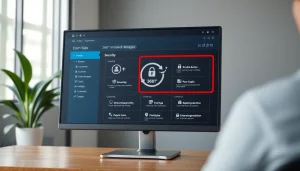Leveraging ai chat bots to Enhance Customer Engagement and Boost Business Efficiency
Understanding the Basics of ai Chat Bots
What is an ai Chat Bot?
In an increasingly digital world, the emergence of ai chat bot technology has revolutionized the way businesses interact with customers. At its core, an AI chat bot is a software application designed to simulate conversation with human users, especially over the Internet. These chat bots utilize artificial intelligence algorithms to understand user queries and provide responses that are contextually relevant and coherent. This interaction can take form in various formats, including text-based chat interfaces, voice interactions, or even graphical interfaces that guide users through decision-making processes.
The Evolution of Chat Bot Technology
The journey of chat bot technology can be traced back to the 1960s and 70s with the development of early programs like ELIZA, which mimicked conversation styles. However, it is in the last decade where we have witnessed profound advancements propelled by machine learning and natural language processing (NLP). Today, chat bots can understand and analyze human language, learn from interactions, and continuously improve their responses based on user feedback. The evolution also reflects broader trends in consumer behavior, where users increasingly prefer instantaneous communication rather than traditional customer service channels.
Key Features of Effective ai Chat Bots
Effective ai chat bots are characterized by several key features, which enhance user experience and optimize business operations:
- Natural Language Processing: This allows chat bots to understand and respond using colloquial language, making interactions feel more human-like.
- 24/7 Availability: AI chat bots can operate round the clock without fatigue, improving customer service accessibility.
- Personalization: By utilizing data, chat bots can tailor responses to individual users, enhancing engagement and satisfaction.
- Integration Capabilities: They can be integrated with various platforms, including CRM systems, eCommerce platforms, and social media, providing seamless customer experiences.
- Analytics and Reporting: Chat bots can provide insightful data on customer interactions, preferences, and behaviors, helping businesses refine their strategies.
The Importance of ai Chat Bots in Business
Benefits of Implementing ai Chat Bots
Implementing ai chat bots in business operations presents a myriad of benefits, including:
- Cost Efficiency: By automating routine inquiries and tasks, businesses can significantly reduce operational costs associated with human resources.
- Enhanced Customer Experience: Prompt responses and assistance lead to higher customer satisfaction and retention rates.
- Data Collection and Insights: Chat bots can effortlessly gather data from interactions, provide insights on user behavior, and help refine marketing strategies.
- Improved Response Time: Instantaneous replies to customer inquiries enhance the overall efficiency of business communication.
Common Use Cases for ai Chat Bots
AI chat bots have found applications across various sectors. Some common use cases include:
- Customer Support: Handling FAQs and troubleshooting common issues without human intervention.
- E-commerce: Assisting customers in product discovery, order tracking, and even sales.
- Booking and Reservations: Automating appointment scheduling for services like restaurants or clinics.
- Lead Generation: Gathering contact information and qualifying leads via initial conversations.
- Employee Support: Streamlining internal processes by answering employee queries related to HR policies or IT support.
Measuring the Impact of ai Chat Bots on Customer Engagement
To ensure that ai chat bots are effectively enhancing customer engagement, businesses must establish metrics to evaluate their performance. Key performance indicators (KPIs) to monitor include:
- User Engagement Rate: Analyze how frequently users interact with chat bots compared to traditional support channels.
- Response Time: Assess the average time taken for chat bots to provide responses to user inquiries.
- Customer Satisfaction Scores: Conduct surveys to gauge user satisfaction post-interaction to fine-tune performance.
- Conversion Rates: Measure how many interactions lead to desired actions, such as purchases or lead submissions.
Design Principles for Optimal ai Chat Bot Interactions
Creating a User-Centric Interface
The design of an ai chat bot interface should focus on user experience and accessibility. A user-centric interface involves:
- Simplicity: Avoid cluttered interfaces—keep the design intuitive to encourage user interaction.
- Clear Call-to-Actions: Guide users through interactions with easily identifiable prompts and buttons.
- Accessibility: Ensure that the interface is accessible to users with disabilities, incorporating features such as screen reader compatibility.
Conversational Design Best Practices
Effective conversational design is crucial for creating engaging interactions. Best practices include:
- Personalization: Use user data to make conversations feel tailored and relevant.
- Empathy in Responses: Incorporate emotional intelligence into chat bot responses to build rapport with users.
- Contextual Understanding: Ensure that without getting users lost in conversation, chat bots understand the context of previous questions.
Integrating Multimodal Interactions with ai Chat Bots
Incorporating multimodal capabilities allows chat bots to engage users across different formats. This can include:
- Text and Voice Interactions: Offering both chat and voice commands can cater to different user preferences.
- Visual Elements: Using images, buttons, and links enhances engagement, leading to rich user experiences.
- Multi-Platform Integration: Allow users to interact via their preferred platform, be it apps, websites, or social media.
Implementing ai Chat Bots: Best Practices
Step-by-Step Guide to Launching an ai Chat Bot
Launching an ai chat bot requires careful planning and execution. Here’s a step-by-step guide:
- Define Objectives: Determine what you want your chat bot to accomplish, whether it’s reducing support costs or improving response times.
- Select the Right Technology: Choose a platform that aligns with your technical requirements and business needs.
- Design the Conversation Flow: Map out user interactions and anticipate common queries to develop an effective conversation flow.
- Test Rigorously: Pilot the chat bot with a small user group; continuity of feedback should guide adjustments.
- Launch and Monitor: Once operational, continually monitor interactions and KPIs to make improvements.
Choosing the Right Platform for Your ai Chat Bot
Selecting a suitable platform involves evaluating various aspects such as:
- Integration Capabilities: Ensure that the platform can integrate seamlessly with your existing systems.
- User-Friendliness: The platform should offer an intuitive interface for setting up and managing the chat bot.
- Scalability: Consider platforms that can grow alongside your business to accommodate increased user interactions and nuanced capabilities.
Training Your ai Chat Bot for Better Performance
An ai chat bot’s performance largely depends on its training. Suggested methods for effective training include:
- Using Historical Data: Leverage past interaction data to train the AI in understanding common inquiries and responses.
- Implement Continuous Learning: Utilize machine learning capabilities to allow the chat bot to learn and improve from ongoing interactions.
- Regular Updates: Regularly update the knowledge base and training algorithms to accommodate changing products and services.
Future Trends in ai Chat Bot Development
AI Advancements Shaping the Future of Chat Bots
Several AI advancements are set to shape the future of chat bots, including:
- Enhanced Natural Language Processing: Continued improvements in NLP will enable chat bots to understand nuanced language and even colloquialisms.
- Emotion Recognition: Future chat bots may incorporate advanced emotion detection to respond empathetically to user emotions.
- Improved Personalization: AI capabilities will further enhance the customization of interactions based on individual user behavior.
Ethical Considerations in ai Chat Bot Usage
As reliance on ai chat bots increases, ethical considerations must also be addressed, including:
- Transparency: Users should be informed when they are interacting with a bot rather than a human.
- Data Privacy: Ensuring that user data collected by chat bots is stored securely and in compliance with regulations.
- Bias Mitigation: Developers must work to eliminate any biases in AI training data to prevent skewed responses.
Preparing for the Next Generation of User Interactions
To remain competitive, businesses must prepare for further developments in user interactions with chat bots, such as:
- Increased Use of Voice Assistants: With the proliferation of voice-activated devices, integrating voice capabilities will be critical.
- Emotional Intelligence: Future chat bots might leverage emotional analytics to respond with appropriate empathy and understanding.
- Seamless Cross-Platform Experiences: Users will expect a consistent experience across all devices and interactions, necessitating better integrations.














Post Comment